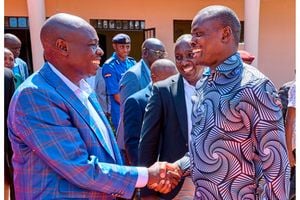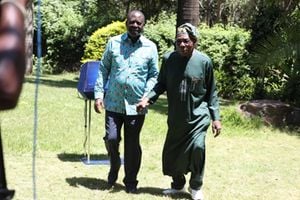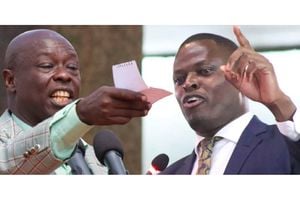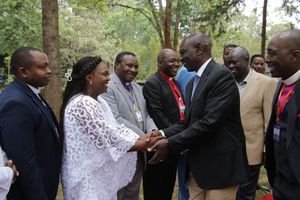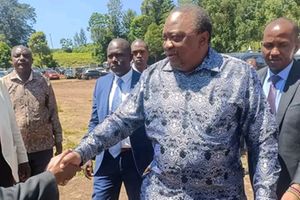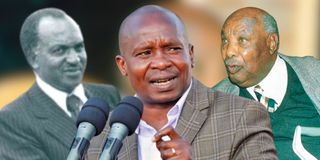
Cabinet Secretary in Ministry of Interior Kithure Kindiki (center) and former powerful Cabinet Ministers Jeremiah Nyagah (left) and Jackson Angaine.
The late Cabinet Minister Jeremiah Nyagah must be turning in his grave, and so is Jackson Harvester Angaine.
During their reign, in the Jomo Kenyatta and Moi governments, Mt Kenya East had a more significant say in national politics to the extent that Nyagah was lining up as Kenyatta’s successor.
For his part, Angaine ran the powerful Lands and Settlements docket and was christened the “King of Meru”.
Thanks to his Lands’ docket, Angaine’s might was felt throughout the country. Not anymore.
Today, the upper eastern region, consisting of Meru, Tharaka Nithi, and Embu, has little say in national politics and is now the leeward side of Mt Kenya politics.
None of the current politicos command national influence – a dearth noticeable in the recent William Ruto succession talk.
Despite a publicity blitz, Prof Kithure Kindiki’s performance at the troubled Ministry of Interior docket could have been better. His struggle to build a national image is apparent.

Interior Cabinet Secretary Kithure Kindiki.
Previously, some Security docket holders had an easy rise and became the most powerful individuals in Kenya. These titans included John Michuki, Dr Fred Matiang’i, G.G. Kariuki, Dr Njoroge Mungai, and Justus Ole Tipis.
But Prof Kindiki, apart from his love of combat uniform, has not established his authority within the ranks.
As some say, his powers were deliberately whittled down when he lost the ability to have any say on the police billions and structures.
Compared to previous office holders, Prof Kindiki lacks the intimidating and overwhelming presence of Matiang’i or Michuki when dealing with the provincial administration.
The bandits and terrorists have tested him, and his failure to streamline the immigration docket has left him open to criticism.
This week, during the UDA retreat, Prof Kindiki’s performance was criticised, and he was given a few weeks to sort out the mess within Nyayo House.
Mithika Linturi, his Agriculture counterpart from the region, is not faring better and has yet to stamp his authority beyond the corridors of Kilimo House.

Cabinet Secretary in the Ministry of Agriculture and Livestock Development Mithika Linturi.
Linturi is incomparable to Jeremiah Nyagah, who held the Agriculture docket for ten years and turned out to be an influential figure in national politics – to the extent that he not only created a family dynasty in Embu but was also thought to be a potential president.
Nyagah had established himself in pre-independence politics as a moderate figure who stood for a multiracial Kenya.
After the 1959 elections, where only loyalists voted under the Lennox-Boyd Constitution, Nyagah became a leading figure in the multiracial Kenya National Party as opposed to the Oginga Odinga-led Kenya Independence Movement, which was demanding a faster transfer of power from the colonial government.
He would even eclipse his central Kenya counterpart Dr Julius Gikonyo Kiano, elected during the same period – and the lacklustre Bernard Mate from Embu.
So instrumental was Nyagah that when Kanu was overhauled in 1966 to tame Jaramogi Oginga Odinga, and which led to the creation of eight new provincial vice-presidents, Nyagah emerged to represent the expansive Eastern province and was appointed the Minister for Education to replace Joseph Otiende.
He would later be shifted to the Ministry of Agriculture after the resignation of Bruce Mackenzie in 1969.
After Kenyatta died in 1978, Moi is thought to have considered Nyagah – and Dr Kiano – as a possible vice-president.
Historians claim that Charles Njonjo floated the name of Mwai Kibaki, his ally in the pro-Moi campaign. It was also a strategy to have Kibaki overshadow the Kiambu politicos who had been eyeing the presidency.
Nyagah would still run against Kibaki in the subsequent Kanu election and would stay relevant in the political space until the dawn of multi-party politics in the 1990s when, at 72, he opted to retire.
Another veteran of the region politics was Angaine, who in 1963 had joined the triumvirate of Bruce Mackenzie, the Minister for Agriculture, and James Gichuru, the Minister for Finance, in controlling the settlement of the landless, the grabbing, and take-over of settler farms.
That position gave Angaine an inside role in the Kenyatta government, and he became the most visible politician from the Meru region in Independent Kenya and held that position from 1963 to 1979.
In 1969, he was elected unopposed, an indicator of his popularity. Because of his pivotal role in the settlement of other communities in the Rift Valley, one MP described him as ‘a leader to hell and darkness’.
He was one of the Cabinet ministers who openly supported the 1977 Change-the-Constitution campaign, whose intention was to stop Daniel arap Moi from succeeding Kenyatta.
Other figures who emerged from this region included Bernard Mate, who eclipsed Eliud Mathu to represent the central province in the colonial legislative council but faded as Angaine rose to become the most influential personality from Meru ever since the region has yet to produce powerful national figures with noticeable influence.
Compared to the 1960s and 1970s, the Meru, Embu, and Tharaka Nithi regions have no powerful kingpins who could rally the local and national politics.
While there were hopes that Kithure Kindiki could emerge as William Ruto’s running mate, the Rigathi Gachagua coup saw Kindiki abandon politics – only to swallow his pride and return as a Cabinet Secretary in the whittled-down Ministry of Interior.
At the moment, as politicians plot on the post-Ruto lineup, it is DP Gachagua and Kiharu MP Ndindi Nyoro who seem to be points of interest.
While Nyoro may have backpedaled from the public display of presidential lust, he may only have retreated but not abandoned his desire to outwit the Deputy President later on.
The lack of a significant figure in the Embu, Meru, and Tharaka Nithi region can partly be attributed to the collapse of the previous Gikuyu Embu and Meru Association (Gema), which had dominated the Mt Kenya politics and had its kingpins within the tribal structures. These were not only influential figures but also commanded the politics at the region and national level.
During its first meeting, Gema had brought together senior politicians, including Mwai Kibaki, Jeremiah Nyagah, G. G. Kariuki, and Dr Julius Kiano.
But these dropped out, according to Moi’s biographer Andrew Morton, “when they saw that Gema was being hijacked by Kiambu chauvinists determined to oust Vice-President Moi”.
Angaine had associated with the Gema power brokers, which is how he retained his might. Nyagah had, on the other hand, retained his moderate stand and had built his own national image out of the respect he commanded as a forthright politician.
After Moi came to power in 1978, he forced Gema to change its name and banished the tribal associations as he tried to consolidate his might in the Mt Kenya region.
Today, Gema is long dead, and it will be hard for Linturi and Prof Kindiki to ever find such a wagon to drive them to power.
More so, even with the advent of multi-party politics, the region has never been steady with any political party. It has shifted from, among others, Kanu, Kibaki’s Democratic Party, Narc, Jubilee, and now Ruto’s UDA.
As it were, the upper Eastern region of Meru, Embu, and Tharaka Nithi has not developed any homegrown political party. While former Cabinet Minister Peter Munya is struggling to revive the Democratic Party, Kiraitu Murungi’s briefcase Devolution Empowerment Party (DEP) has had no impact in the region.
More so, the newcomers to Meru, Tharaka Nithi, and Embu politics still lack the sting of national politics. At best, they are marooned in their little leeward sites.

